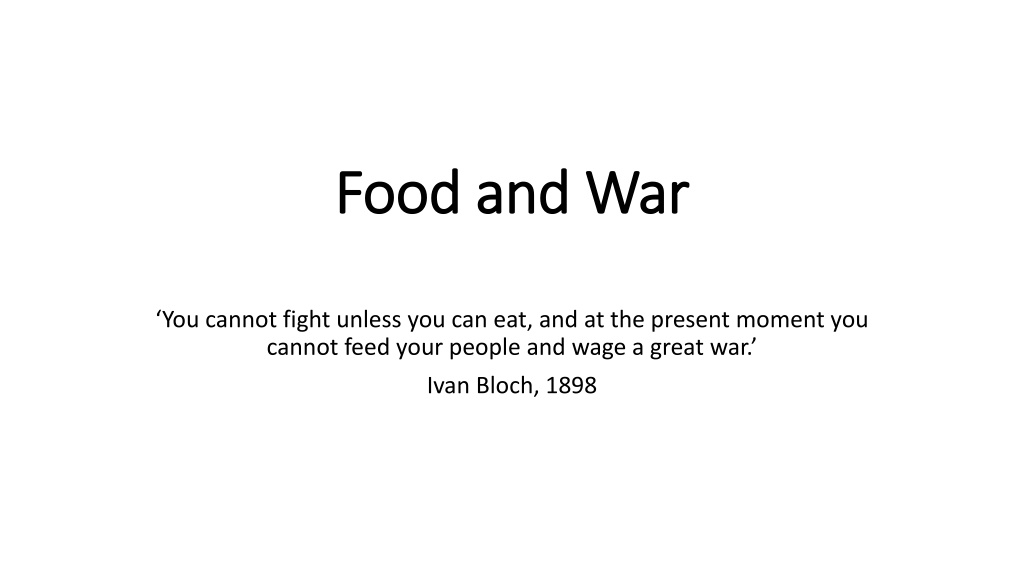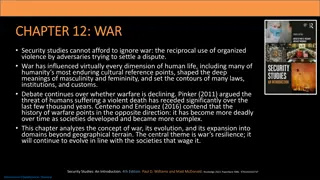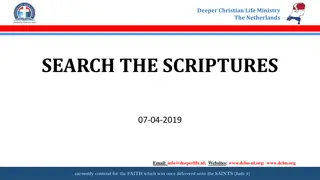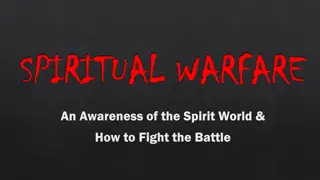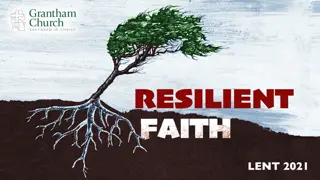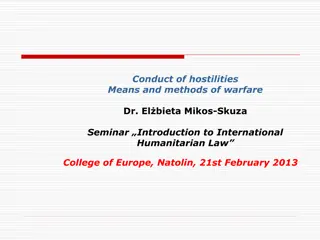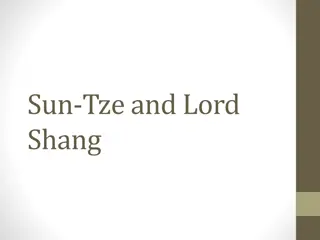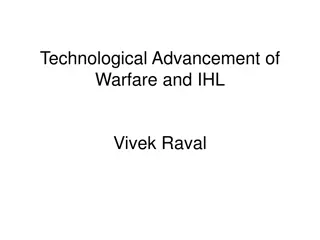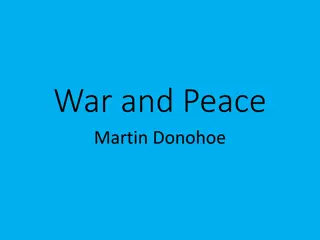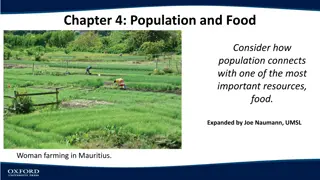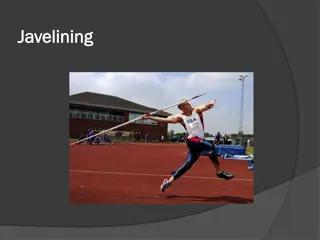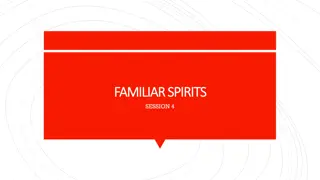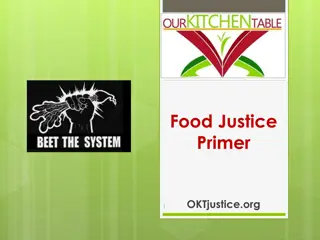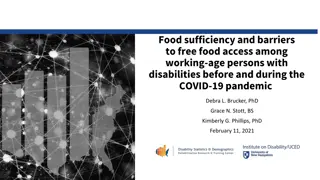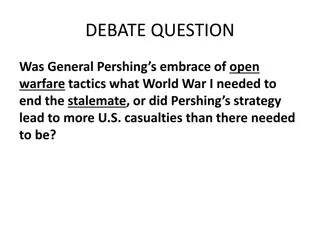The Role of Food in Warfare Throughout History
Explore the intricate relationship between food and war as a keynote on how food scarcity and abundance have influenced conflicts. Delve into topics like food as a cause of war, impact on civilian eating practices, and food as a deliberate weapon in historical events such as the Siege of Leningrad and the Greek Famine. Uncover how states have utilized food policies to shape their relationships with civilians during wartime, reflecting on the profound consequences on societies.
Download Presentation

Please find below an Image/Link to download the presentation.
The content on the website is provided AS IS for your information and personal use only. It may not be sold, licensed, or shared on other websites without obtaining consent from the author. Download presentation by click this link. If you encounter any issues during the download, it is possible that the publisher has removed the file from their server.
E N D
Presentation Transcript
Food and War Food and War You cannot fight unless you can eat, and at the present moment you cannot feed your people and wage a great war. Ivan Bloch, 1898
Themes for the lecture food as a cause of war food as a policy of war feeding the military impact of war on civilian eating practices . . . and some concluding comments about the effect of wartime food policies on the relationship between states and civilians.
Food as a Cause of War Food as a Cause of War desire for agricultural lands has often led to war Ukraine (e.g. work of Scott Nelson) Medieval Tuscany (e.g. work of George Demeron) World War Two (e.g. work of Lizzie Collingham)
Food as a Cause of War Food as a Cause of War desire for agricultural lands has often led to war World War Two is a battle for food, a battle for the basis of life, for the raw materials the earth offers . Adolf Hitler, 1942
Food as a Weapon of War Food as a Weapon of War starving the population Ukraine Medieval Tuscany World War One (UK imported 60% of its food) World War Two
Food as a Weapon of War Food as a Weapon of War starving the population World War Two Herbert Backe Hunger Plan 1.) The war can only be continued if the entire Wehrmacht is fed from Russia in the third year of the war. 2.) If we take what we need out of the country, there can be no doubt that many millions of people will die of starvation.
Siege of Leningrad (Sept 1941 Siege of Leningrad (Sept 1941- -Jan 1944) Jan 1944)
The Warsaw Ghetto (Oct. 1940-May 1943)
Greek Famine (1941 Greek Famine (1941- -1943) 1943)
1944 Dutch Hunger Winter 1944 Dutch Hunger Winter LH Lumey and FW Van Poppel, The Dutch famine of 1944-45: mortality and morbidity in past and present generations , Social History of Medicine 7:2 (1994).
Feeding Soldiers Feeding Soldiers Ukraine British Royal Navy (Victualling Board, 1683- 1832) 20th-century Japanese armed forces Copies of Victualling Board instructions, list of provisions for one month, expense of freight, London to Portsmouth and Plymouth, 1795 Royal Museums Greenwich
Feeding Civilians Feeding Civilians
Feeding Civilians Feeding Civilians 20th-century Japan Far East Survey (1946) Korokke
Feeding Civilians Feeding Civilians Some themes from World Wars I and II patriotic messages about the connections between individual eating habits and the war effort campaigns to increase agricultural production rationing and dietary guidelines/regulations emphasis on autarky/economic nationalism communal feeding schemes (canteens, national restaurants, school meals) Concern about the impact of hunger on morale civilian expectation that the state had a duty to feed its citizens
Feeding Civilians Feeding Civilians Germany during World War One Prior to the war Germany had imported about a third of its overall food needs
Feeding Civilians Feeding Civilians Germany during World War One K-brot Kriegsbrot or Kartoffelbrot (War-Bread or Potato- Bread) A piece of K-brot preserved in the Imperial War Museum, London
Feeding Civilians Feeding Civilians Germany during World War One Germany did not run out of rifles or shells. It suffered badly from shortages of food. Likewise the Allies: their agrarian resources decided the war. So not only a war or steel and gold, but a war of bread and potatoes. Avner Offer, The First World War: An Agrarian Interpretation (Oxford, 1989).
Feeding Civilians Feeding Civilians Germany during the World Wars Nazi domestic science magazines advised on how to avoid food waste, as part of the war effort, and as a duty to the fatherland
Feeding Civilians Feeding Civilians Germany during the World Wars Germany during the World Wars There was little need to convince consumers to eat potatoes. But the [Nazi] Women s Bureau was terribly concerned about how those potatoes were peeled. Sloppy peeling (where some of the inner, white part of the potato was cut off with the peel) was allegedly responsible for the wastage of tons of potatoes every year. To avoid this, Nazi women s groups repeatedly urged consumers to eat [potatoes cooked in their peel, or] Pellkartoffeln, because peeling cooked potatoes meant that the peel came off easily (although they admitted that peeling hot potatoes stung one s fingers). Cold unappetizing leftover bits of potatoes were another recurring problem for the Home Economics Section: not a scrap should go to waste. Nazi Party women s agencies generated hundreds of recipe tips, offering housewives recipes (often entailing much more work than the original menu that had created the leftovers) to enable them to recycle and use up those cold remnants. Nancy Reagin, Sweeping the German Nation: Domesticity and National Identity in Germany, 1870-1945 (Cambridge, 2007)
Conclusions Conclusions Histories of warfare need to pay close attention to food. Starvation, as much as death in conflict, is a fundamental feature of all wars.
Conclusions Conclusions Histories of warfare need to pay close attention to food. Starvation, as much as death in conflict, is a fundamental feature of all wars. wartime experiences can change a nation s overall dietary practices and can lead to long-term changes in health.
Conclusions Conclusions Histories of warfare need to pay close attention to food. Starvation, as much as death in conflict, is a fundamental feature of all wars. wartime experiences can change a nation s overall dietary practices and can lead to long-term changes in health. in 20th-century Western Europe war has helped develop national food policies and build the state institutions that delivered the postwar welfare state. The historian Charles Tilly argued that war makes states . In particular wartime food policies help build states.
Conclusions Conclusions Histories of warfare need to pay close attention to food. Starvation, as much as death in conflict, is a fundamental feature of all wars. wartime experiences can change a nation s overall dietary practices and can lead to long-term changes in health. in 20th-century Western Europe war has helped develop national food policies and build the state institutions that delivered the postwar welfare state. The historian Charles Tilly argued that war makes states . In particular wartime food policies help build states. war can sometimes give civilians agency to influence government policies: In the First World War, food was the site of a dynamic rearrangement between states and new demanding groups in society . (Frank Trentmann and Flemming Just, Introduction , Food and Conflict in Europe in the Age of the Two World Wars, eds. Frank Trentmann and Flemming Just (2006).)
In World War One Germany, wartime food experiences redefined the relationship between civilians and the state This insight challenges still-dominant assumptions regarding the nature of politics itself as representing a narrow terrain of activity, largely separated from the rest of everyday life, practiced only at particular moments and often by limited segments of society. Contemporary documents suggest that officials interpreted bread riots in the street and even the simple act of queuing in long lines for bread as political by implication. Officials treatment of this activity as political set the pace for the public interpretation of the economic war and its unwilling victims. The boarder public, too including the disenfranchised played a role in defining politics. Belinda Davis, Home Fires Burning: Food, Politics, and Everyday Life in World War I Berlin (Chapel Hill, 2000).
Interwar Germany Interwar Germany Berliners began to develop a new politics of entitlement, though the bases for this perceived entitlement varied widely among different populations and over the course of the war. For some this entitlement related to basic human needs; for others it instead (or also) connected to one s contribution to the war effort. Some Berliners based their demands on their identity as citizens or proto-citizens. For others this was also a question of national identity, in an inclusive and sometimes quite exclusive sense. Belinda Davis, Home Fires Burning: Food, Politics, and Everyday Life in World War I Berlin (Chapel Hill, 2000).
